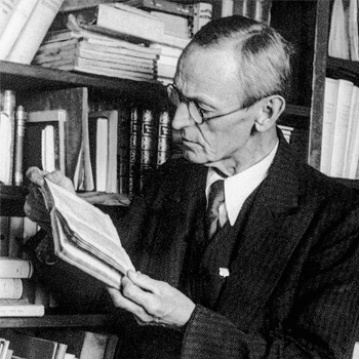
From 1919 through 1943, Hesse wrote six novels that helped lead young people to the spiritual path, a champion among meditators and psychedelic adventurers. As Timothy Leary wrote, “Hesse is the master guide to the psychedelic experience.” He also enlightened readers about psychological projection in “Demian” (1919), writing, “If you hate a person, you hate something in him that is part of yourself. What isn’t part of ourselves doesn’t disturb us.”
Trust Your Self
In “Demian,” Hesse invited us to trust the inner voice:
“I have ceased to question stars and books; I have begun to listen to the teaching my blood whispers to me…. I wanted only to live in accord with the promptings which came from my true self.”
In “Siddhartha” too: “A seeker after truth cannot accept any doctrine, not if he truly wishes to find. One who has found, however – he can approve of every doctrine.”
Unique Individual
Writing during both world wars when individual dignity was ignored, Hesse called for the uniqueness of each person:
“Every man is more than just himself; he also represents the unique, the very special and always significant and remarkable point at which the world’s phenomena intersect, only once in this way, and never again. That is why every man’s story is important, eternal, sacred; that is why every man, as long as he lives and fulfills the will of nature, is wondrous, and worthy of consideration. In each individual the spirit has become flesh, in each man the creation suffers, within each one a redeemer is nailed to the cross.”
Spiritual Metaphors
His “Journey to the East” (1932) was “not only a country and a geographical location but rather the homeland of the soul’s youth, the everywhere and nowhere, the oneness of all times.” “The Glass Bead Game” (1943), for which Hesse won his Nobel Prize, was “the sum total of everything spiritual and artistic.”
In it, he wrote of the peace that comes through spiritual mastery:
“This serenity is neither frivolousness nor self-complacency; it is the highest wisdom and love, the affirmation of all reality, the wide-awakeness at the brink of all depths and abysses, the virtue of the saints and the knights.”
Transcendence, Detachment And Laughter
In “Steppenwolf” (1927) protagonist Harry Haller learned, in the Magic Theater, the freedom that comes with letting go, detachment, and laughter:
“this music was something like time frozen to space, and above it hovered a superhuman serenity, an eternal, divine laughter.”
The inner journeyer of a writer elsewhere wrote:
“We must become so alone, so utterly alone, that we withdraw into our innermost self.… But then our solitude is overcome, we are no longer alone, for we find that our innermost self is the spirit, that it is God, the indivisible. And suddenly we find ourselves in the midst of the world, yet undisturbed by its multiplicity, for our innermost soul we know ourselves to be one with all being.”
Hesse understood the spiritual detachment of the East, what St. Paul called “being in the world, but not of it.” He wrote: “Some of us think holding on makes us strong but sometimes it is letting go.” Hesse knew that, while the spiritual seeker is serious, the spiritual finder comes face to face with the laughter of the cosmos: “Learn what is to be taken seriously and laugh at the rest.” Spiritual insight meant living from the freedom of Eternity within each moment in time:
“To live in the world as if it were not the world, to respect the law of succession and transiency, to transcend each moment by fitting it into a timeless harmony, in short, to live in harmony.”
The journey to the East brings you to the infinity and eternity of this very moment here and now.






















